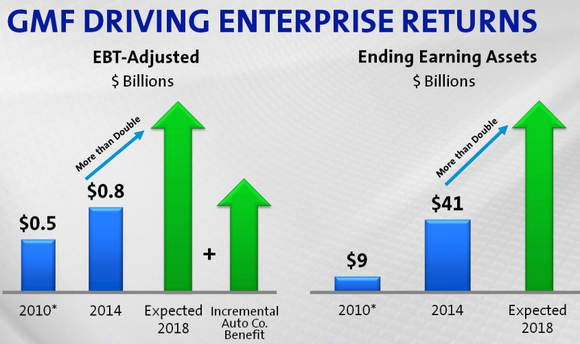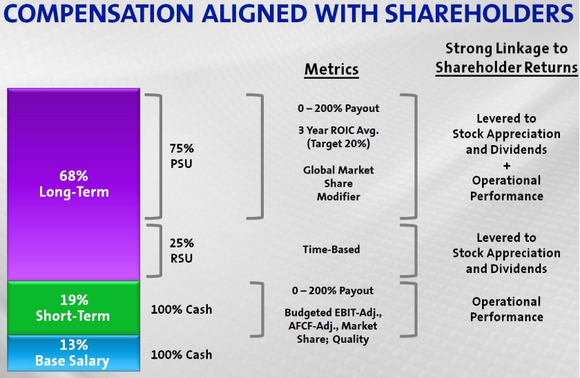
General Motors headquarters in Detroit. Source: General Motors.
Unless you've been living under a rock recently, you've surely noticed the huge drop in fuel prices -- it's been great for drivers across the country. It's especially great news for Detroit automakers like General Motors (GM 1.91%), which produces a plethora of large SUVs, crossovers and full-size trucks. Profits will be better this year, to be sure. However, with the surging sales of SUVs occupying most headlines about GM, there are two great signs for General Motors that investors might have overlooked.
Following in Ford's footsteps
One huge positive factor that's often overlooked for both Ford and GM is their financial divisions. General Motors is finally making significant progress toward accelerating the profitability of GM Financial.
The story behind General Motors Finance, or GMF, is a pretty wild ride. General Motors Acceptance Corporation (GMAC), now known as Ally Financial, was created by GM in 1919 to provide credit -- since more than 90% of vehicle retail sales are financed -- to consumers and dealerships. Similar to traditional banks, General Motors made good profits from its finance arm. In fact, in 2003 GMAC generated $2.8 billion for Old GM's bottom line. For comparison, Ford Motor Company's (F 0.64%) Ford Credit, which is arguably the best finance arm in the automotive industry today, generated roughly $1.9 billion in pre-tax profits last year.
Slowly, GMAC began expanding its focus, growing from providing credit to consumers and dealers for new-car sales to taking on mortgage operations. But by 2006, GM was under financial distress and needed capital, so it sold 51% of GMAC for roughly $14 billion. And as the housing boom turned to bust in the late 2000s, GM's once very profitable finance division was plagued with significant losses. Then in 2008 when the company received government assistance, part of the approval process required that GM have no controlling interest in GMAC going forward.
Realizing what an asset GM's finance arm had been before it expanded its focus, the company aimed to rebuild it. General Motors acquired AmeriCredit Corporation in 2010 and promptly renamed it General Motors Financial Company. Then in 2013 GM Financial purchased Ally's international auto lending operations, which reportedly doubled GM's in-house lending business. As you can see below, GMF is planning to generate much more profits by 2018.

Chart source: GM's Returning Value to Shareholders presentation March 2015.
As GM continues to expand GM Financial, its profitability potential is larger than many investors realize. Let's use rival Ford as an example. Ford Motor Credit (Ford's financial division) is more profitable than any of its regions aside from North America and represented nearly 30% of its pre-tax profits last year. GM Financial, on the other hand, produced about half as much pre-tax profit as Ford Credit, and it only represented 12% of GM's overall pre-tax results.
Furthermore, GMF's growth will come from increasing the percentage of GM retail sales it finances. Right now, GMF finances about 21% of GM's U.S. sales, which is far behind Ford Credit's 45%. GMF also has more upside because GM sells roughly 3 million more vehicles globally than Ford.
Aside from accelerated near-term profits for GM Financial, there's another reason for shareholders of GM to be excited.
Incentives are aligned
After the unique bankruptcy and government bailout of General Motors, there was a fine line to walk with executive compensation at the automaker. On one hand, the government wanted more money removed from excessive executive pay until taxpayers recovered most of the bailout funds. On the other hand, restricting executive compensation too far would cripple the talent pool GM could attract, and that would make GM's turnaround process in the competitive automotive industry more difficult than it already was.
Now, with taxpayers having recovered all of the bailout funds that we're ever going to get, GM is attempting to continue setting its executive compensation in a transparent way that better aligns with shareholders' interests, and is still able to attract top-level talent.

Chart source: GM's Returning Value to Shareholders presentation March 2015.
Right off the bat you'll notice that almost 70% of the compensation will be from long-term objectives such as a return on invested capital higher than 20% for a three-year average and goals for increased global market share. With executives more focused on those aspects, shareholders should be more confident GM's stock can beat the market going forward.
Both of these topics send great signals to shareholders. Incremental profits will be coming as soon as next year via General Motors Financial, and with compensation linked to ROIC it all but guarantees the company will continue to focus on reviving sales of its Cadillac brand -- which will have eight new models on the road globally by 2020 -- because it will need higher margins going forward. As a shareholder, these two developments make me very happy.
